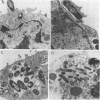Abstract
The organism Afipia felis, which is though to be an etiologic agent of cat scratch disease, is a gram-negative rod that is clearly seen in infected tissue but is very difficult to isolate from clinical specimens; there has been only one report to date of the successful isolation and maintenance of the bacterium on artificial medium. We have found that A. felis will attach, invade via phagocytosis, and multiply intracellularly within the phagosomes of primary human monocytes and HeLa cells. Once in the cell, the bacterium appears to change morphologically, becoming longer and more pleomorphic, and loses its ability to grow on an artificial medium. Unique proteins have been identified in both the intra- and extracellular variants of A. felis. Convalescent-phase sera from patients with cat scratch disease react poorly with intracellular and extracellular bacteria, suggesting a poor humoral response. The tissue culture protocol presented has been used to isolate 14 new strains of A. felis and has for the first time permitted study of the pathogenesis of this unique organism.
Full text
PDF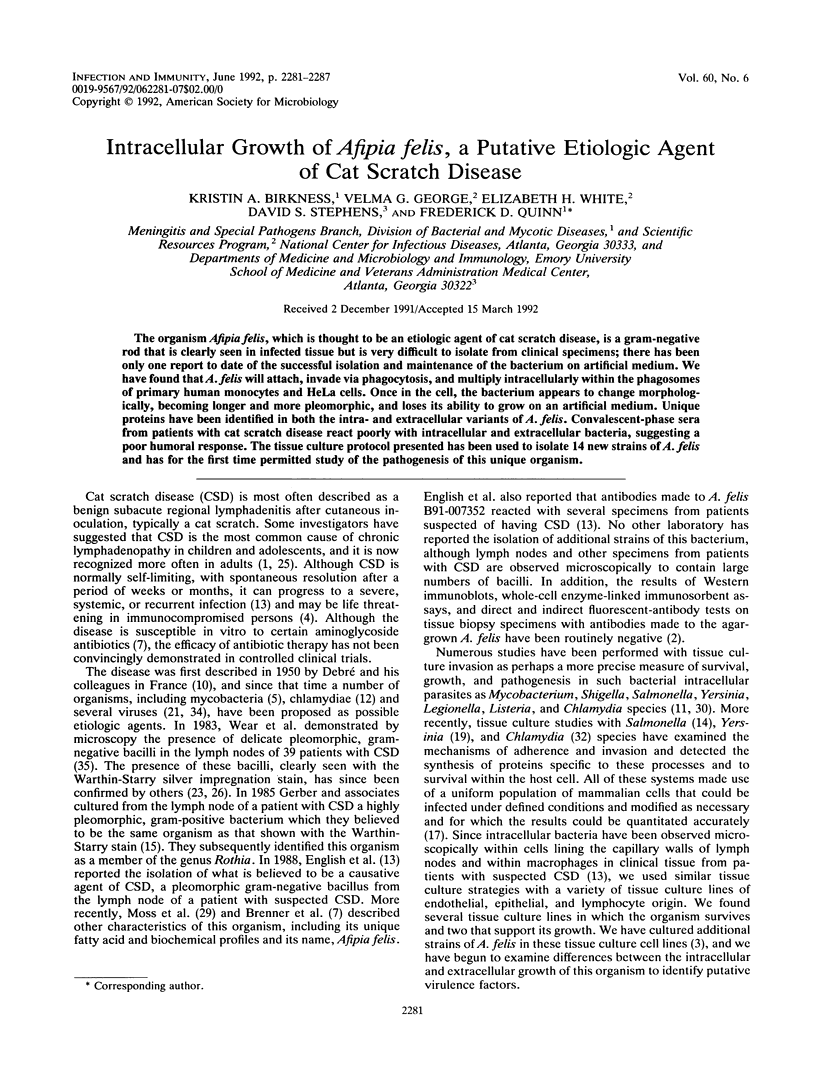

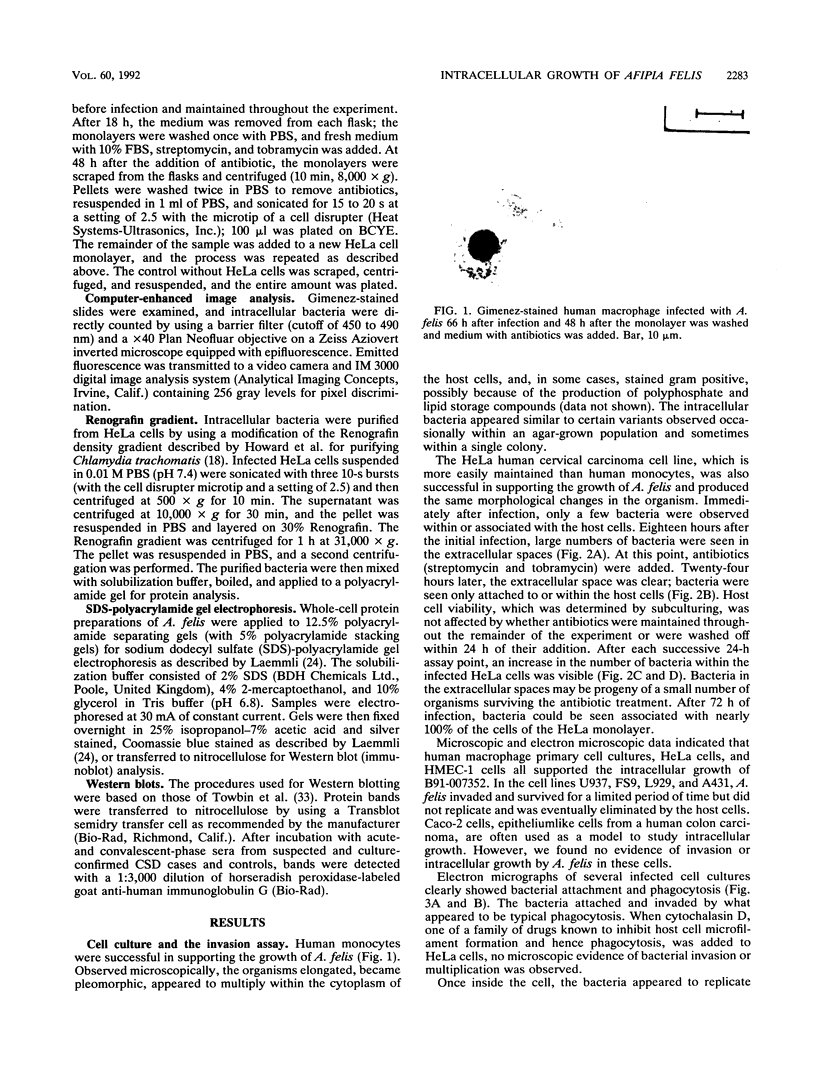
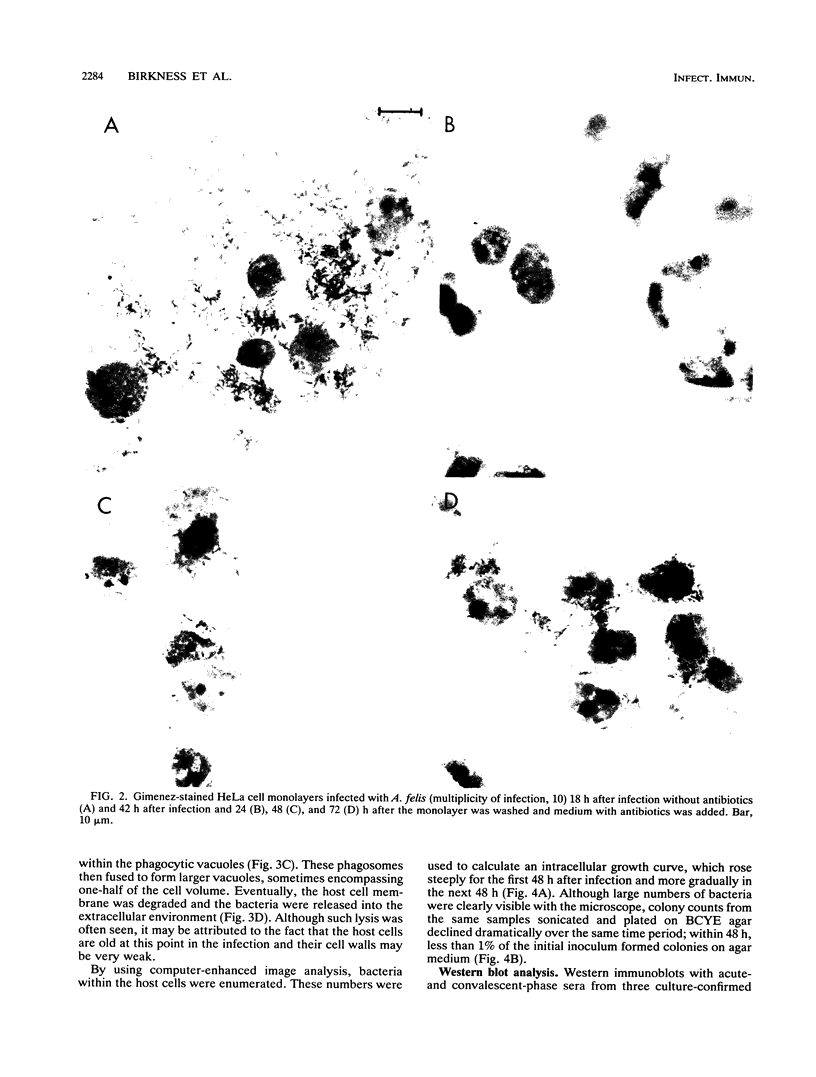
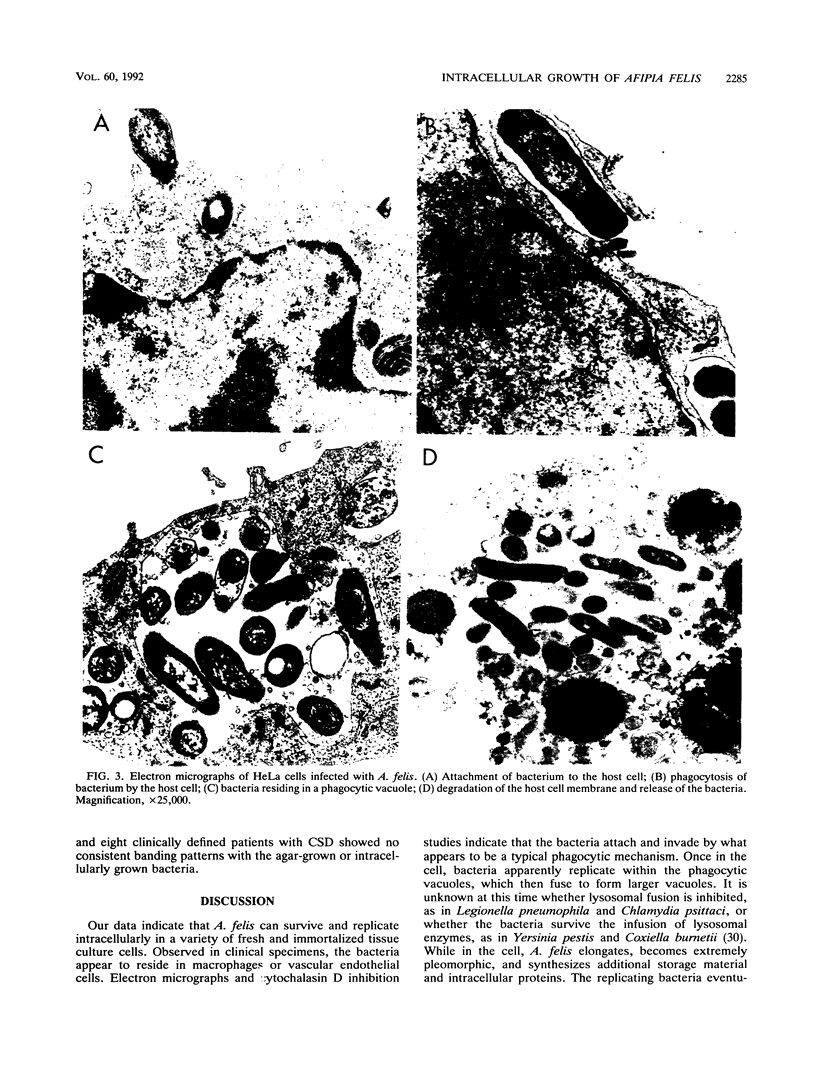
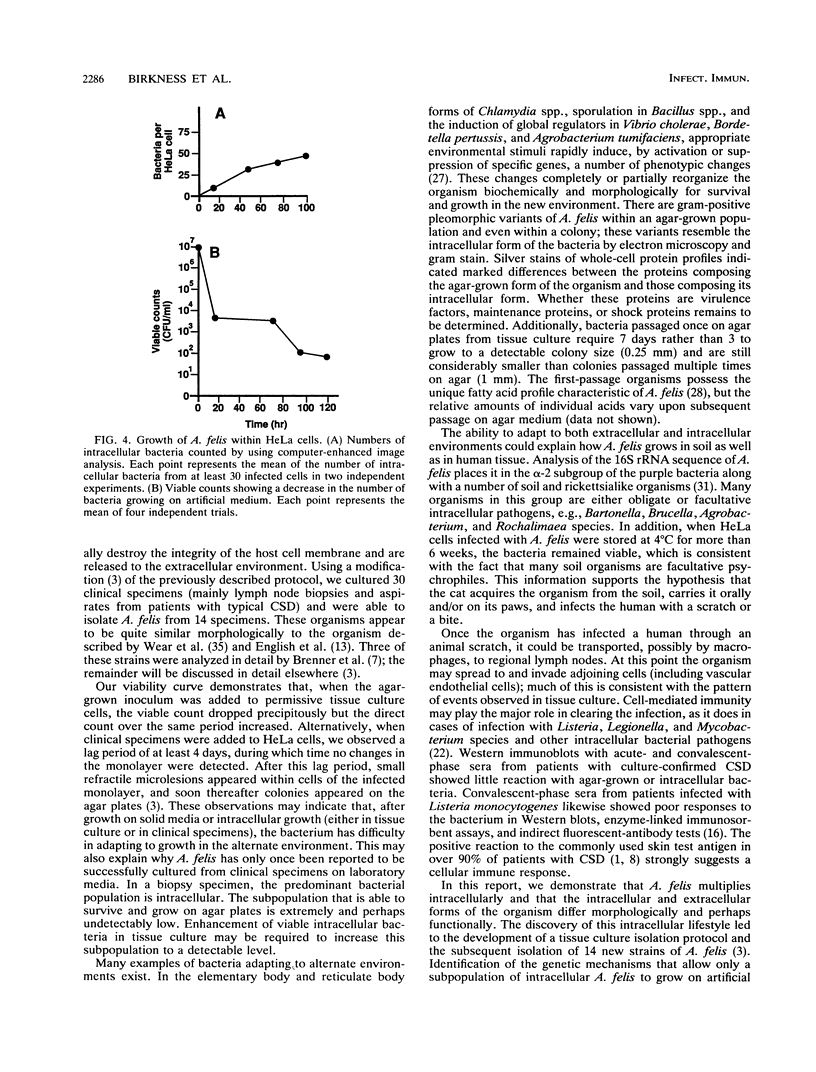
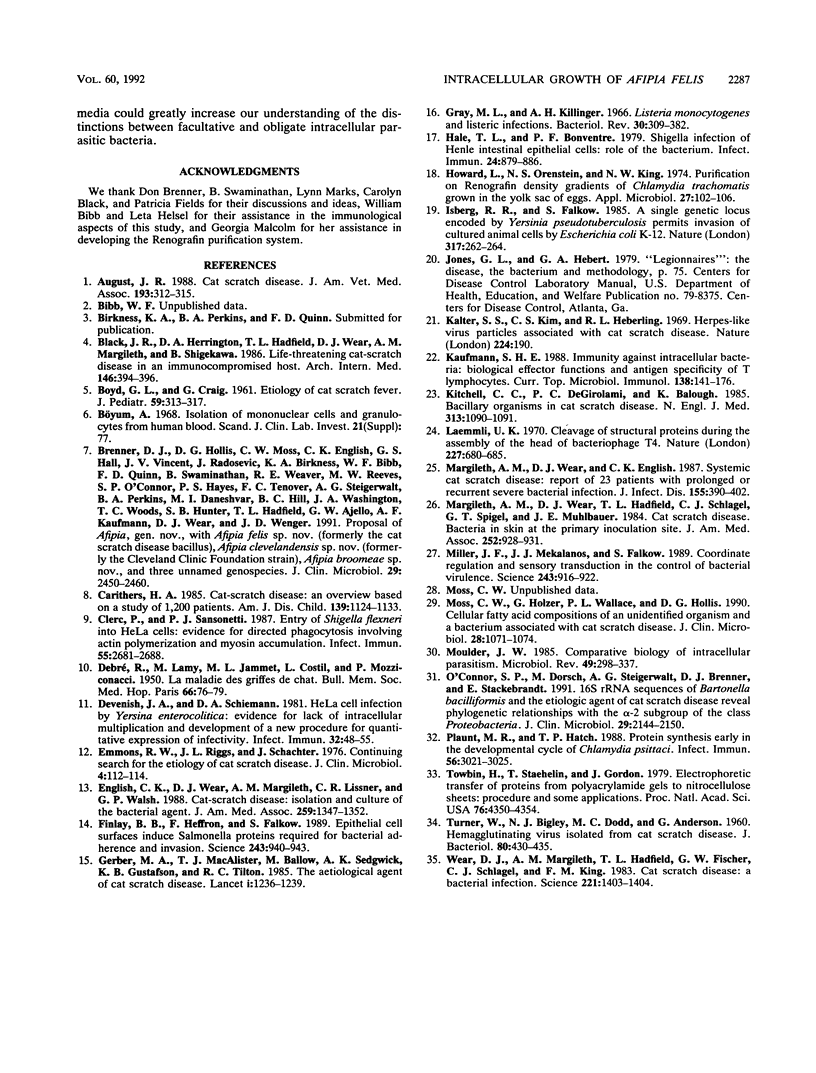
Images in this article
Selected References
These references are in PubMed. This may not be the complete list of references from this article.
- August J. R. Cat scratch disease. J Am Vet Med Assoc. 1988 Aug 1;193(3):312–315. [PubMed] [Google Scholar]
- Black J. R., Herrington D. A., Hadfield T. L., Wear D. J., Margileth A. M., Shigekawa B. Life-threatening cat-scratch disease in an immunocompromised host. Arch Intern Med. 1986 Feb;146(2):394–396. [PubMed] [Google Scholar]
- Brenner D. J., Hollis D. G., Moss C. W., English C. K., Hall G. S., Vincent J., Radosevic J., Birkness K. A., Bibb W. F., Quinn F. D. Proposal of Afipia gen. nov., with Afipia felis sp. nov. (formerly the cat scratch disease bacillus), Afipia clevelandensis sp. nov. (formerly the Cleveland Clinic Foundation strain), Afipia broomeae sp. nov., and three unnamed genospecies. J Clin Microbiol. 1991 Nov;29(11):2450–2460. doi: 10.1128/jcm.29.11.2450-2460.1991. [DOI] [PMC free article] [PubMed] [Google Scholar]
- Böyum A. Isolation of mononuclear cells and granulocytes from human blood. Isolation of monuclear cells by one centrifugation, and of granulocytes by combining centrifugation and sedimentation at 1 g. Scand J Clin Lab Invest Suppl. 1968;97:77–89. [PubMed] [Google Scholar]
- Carithers H. A. Cat-scratch disease. An overview based on a study of 1,200 patients. Am J Dis Child. 1985 Nov;139(11):1124–1133. doi: 10.1001/archpedi.1985.02140130062031. [DOI] [PubMed] [Google Scholar]
- Clerc P., Sansonetti P. J. Entry of Shigella flexneri into HeLa cells: evidence for directed phagocytosis involving actin polymerization and myosin accumulation. Infect Immun. 1987 Nov;55(11):2681–2688. doi: 10.1128/iai.55.11.2681-2688.1987. [DOI] [PMC free article] [PubMed] [Google Scholar]
- Devenish J. A., Schiemann D. A. HeLa cell infection by Yersinia enterocolitica: evidence for lack of intracellular multiplication and development of a new procedure for quantitative expression of infectivity. Infect Immun. 1981 Apr;32(1):48–55. doi: 10.1128/iai.32.1.48-55.1981. [DOI] [PMC free article] [PubMed] [Google Scholar]
- Emmons R. W., Riggs J. L., Schachter J. Continuing search for the etiology of cat scratch disease. J Clin Microbiol. 1976 Jul;4(1):112–114. doi: 10.1128/jcm.4.1.112-114.1976. [DOI] [PMC free article] [PubMed] [Google Scholar]
- English C. K., Wear D. J., Margileth A. M., Lissner C. R., Walsh G. P. Cat-scratch disease. Isolation and culture of the bacterial agent. JAMA. 1988 Mar 4;259(9):1347–1352. doi: 10.1001/jama.259.9.1347. [DOI] [PubMed] [Google Scholar]
- Finlay B. B., Heffron F., Falkow S. Epithelial cell surfaces induce Salmonella proteins required for bacterial adherence and invasion. Science. 1989 Feb 17;243(4893):940–943. doi: 10.1126/science.2919285. [DOI] [PubMed] [Google Scholar]
- Gerber M. A., Sedgwick A. K., MacAlister T. J., Gustafson K. B., Ballow M., Tilton R. C. The aetiological agent of cat scratch disease. Lancet. 1985 Jun 1;1(8440):1236–1239. doi: 10.1016/s0140-6736(85)92311-6. [DOI] [PubMed] [Google Scholar]
- Gray M. L., Killinger A. H. Listeria monocytogenes and listeric infections. Bacteriol Rev. 1966 Jun;30(2):309–382. doi: 10.1128/br.30.2.309-382.1966. [DOI] [PMC free article] [PubMed] [Google Scholar]
- Hale T. L., Bonventre P. F. Shigella infection of Henle intestinal epithelial cells: role of the bacterium. Infect Immun. 1979 Jun;24(3):879–886. doi: 10.1128/iai.24.3.879-886.1979. [DOI] [PMC free article] [PubMed] [Google Scholar]
- Howard L., Orenstein N. S., King N. W. Purification on renografin density gradients of Chlamydia trachomatis grown in the yolk sac of eggs. Appl Microbiol. 1974 Jan;27(1):102–106. doi: 10.1128/am.27.1.102-106.1974. [DOI] [PMC free article] [PubMed] [Google Scholar]
- Isberg R. R., Falkow S. A single genetic locus encoded by Yersinia pseudotuberculosis permits invasion of cultured animal cells by Escherichia coli K-12. Nature. 1985 Sep 19;317(6034):262–264. doi: 10.1038/317262a0. [DOI] [PubMed] [Google Scholar]
- Kalter S. S., Kim C. S., Heberling R. L. Herpes-like virus particles associated with cat scratch disease. Nature. 1969 Oct 11;224(5215):190–190. doi: 10.1038/224190a0. [DOI] [PubMed] [Google Scholar]
- Kaufmann S. H. Immunity against intracellular bacteria: biological effector functions and antigen specificity of T lymphocytes. Curr Top Microbiol Immunol. 1988;138:141–176. [PubMed] [Google Scholar]
- Kitchell C. C., DeGirolami P. C., Balogh K. Bacillary organisms in cat scratch disease. N Engl J Med. 1985 Oct 24;313(17):1090–1091. doi: 10.1056/NEJM198510243131715. [DOI] [PubMed] [Google Scholar]
- Laemmli U. K. Cleavage of structural proteins during the assembly of the head of bacteriophage T4. Nature. 1970 Aug 15;227(5259):680–685. doi: 10.1038/227680a0. [DOI] [PubMed] [Google Scholar]
- Margileth A. M., Wear D. J., English C. K. Systemic cat scratch disease: report of 23 patients with prolonged or recurrent severe bacterial infection. J Infect Dis. 1987 Mar;155(3):390–402. doi: 10.1093/infdis/155.3.390. [DOI] [PubMed] [Google Scholar]
- Margileth A. W., Wear D. J., Hadfield T. L., Schlagel C. J., Spigel G. T., Muhlbauer J. E. Cat-scratch disease. Bacteria in skin at the primary inoculation site. JAMA. 1984 Aug 17;252(7):928–931. doi: 10.1001/jama.252.7.928. [DOI] [PubMed] [Google Scholar]
- Miller J. F., Mekalanos J. J., Falkow S. Coordinate regulation and sensory transduction in the control of bacterial virulence. Science. 1989 Feb 17;243(4893):916–922. doi: 10.1126/science.2537530. [DOI] [PubMed] [Google Scholar]
- Moss C. W., Holzer G., Wallace P. L., Hollis D. G. Cellular fatty acid compositions of an unidentified organism and a bacterium associated with cat scratch disease. J Clin Microbiol. 1990 May;28(5):1071–1074. doi: 10.1128/jcm.28.5.1071-1074.1990. [DOI] [PMC free article] [PubMed] [Google Scholar]
- Moulder J. W. Comparative biology of intracellular parasitism. Microbiol Rev. 1985 Sep;49(3):298–337. doi: 10.1128/mr.49.3.298-337.1985. [DOI] [PMC free article] [PubMed] [Google Scholar]
- O'Connor S. P., Dorsch M., Steigerwalt A. G., Brenner D. J., Stackebrandt E. 16S rRNA sequences of Bartonella bacilliformis and cat scratch disease bacillus reveal phylogenetic relationships with the alpha-2 subgroup of the class Proteobacteria. J Clin Microbiol. 1991 Oct;29(10):2144–2150. doi: 10.1128/jcm.29.10.2144-2150.1991. [DOI] [PMC free article] [PubMed] [Google Scholar]
- Plaunt M. R., Hatch T. P. Protein synthesis early in the developmental cycle of Chlamydia psittaci. Infect Immun. 1988 Dec;56(12):3021–3025. doi: 10.1128/iai.56.12.3021-3025.1988. [DOI] [PMC free article] [PubMed] [Google Scholar]
- TURNER W., BIGLEY N. J., DODD M. C., ANDERSON G. Hemagglutinating virus isolated from cat scratch disease. J Bacteriol. 1960 Oct;80:430–435. doi: 10.1002/path.1700800229. [DOI] [PMC free article] [PubMed] [Google Scholar]
- Towbin H., Staehelin T., Gordon J. Electrophoretic transfer of proteins from polyacrylamide gels to nitrocellulose sheets: procedure and some applications. Proc Natl Acad Sci U S A. 1979 Sep;76(9):4350–4354. doi: 10.1073/pnas.76.9.4350. [DOI] [PMC free article] [PubMed] [Google Scholar]
- Wear D. J., Margileth A. M., Hadfield T. L., Fischer G. W., Schlagel C. J., King F. M. Cat scratch disease: a bacterial infection. Science. 1983 Sep 30;221(4618):1403–1405. doi: 10.1126/science.6612349. [DOI] [PubMed] [Google Scholar]





